NRS-490: Benchmark Professional Capstone and Practicum Journal
VerifiedAdded on 2022/11/28
|6
|1184
|206
Report
AI Summary
This reflective journal, created for the NRS-490 capstone course, delves into various aspects of healthcare delivery and practice. The journal explores new practice approaches, emphasizing the importance of multidisciplinary teams and inter-professional collaboration in enhancing patient care and outcomes. It examines clinical systems, ethical considerations, and population health concerns, highlighting the role of technology, such as electronic health records, in improving healthcare. Furthermore, the journal discusses health policies, economic models, and leadership within healthcare, addressing health disparities and promoting equitable access to care. References to relevant literature support the analysis of these critical components of modern healthcare, providing a comprehensive overview of the challenges and advancements in the field.
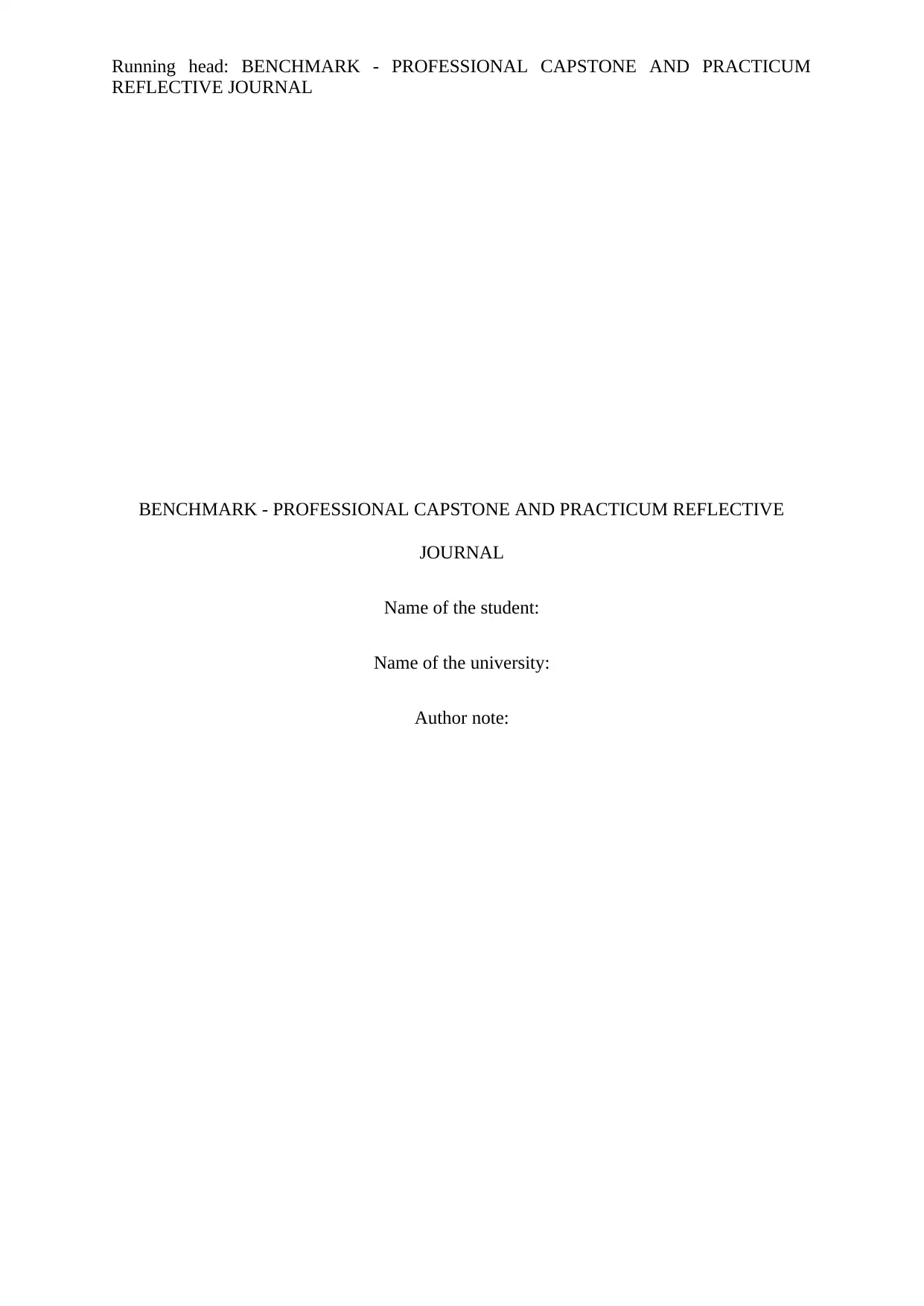
Running head: BENCHMARK - PROFESSIONAL CAPSTONE AND PRACTICUM
REFLECTIVE JOURNAL
BENCHMARK - PROFESSIONAL CAPSTONE AND PRACTICUM REFLECTIVE
JOURNAL
Name of the student:
Name of the university:
Author note:
REFLECTIVE JOURNAL
BENCHMARK - PROFESSIONAL CAPSTONE AND PRACTICUM REFLECTIVE
JOURNAL
Name of the student:
Name of the university:
Author note:
Paraphrase This Document
Need a fresh take? Get an instant paraphrase of this document with our AI Paraphraser
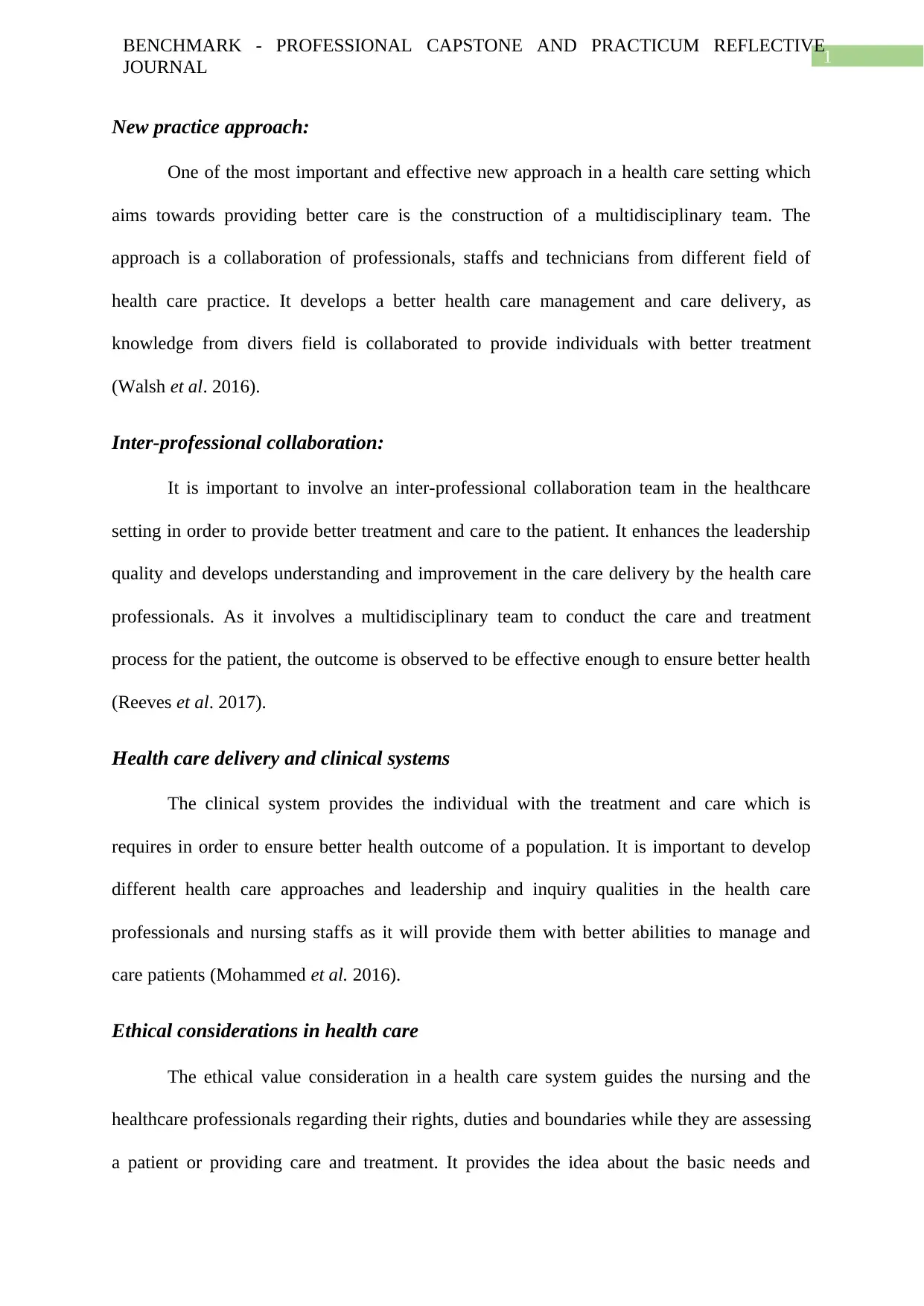
1
BENCHMARK - PROFESSIONAL CAPSTONE AND PRACTICUM REFLECTIVE
JOURNAL
New practice approach:
One of the most important and effective new approach in a health care setting which
aims towards providing better care is the construction of a multidisciplinary team. The
approach is a collaboration of professionals, staffs and technicians from different field of
health care practice. It develops a better health care management and care delivery, as
knowledge from divers field is collaborated to provide individuals with better treatment
(Walsh et al. 2016).
Inter-professional collaboration:
It is important to involve an inter-professional collaboration team in the healthcare
setting in order to provide better treatment and care to the patient. It enhances the leadership
quality and develops understanding and improvement in the care delivery by the health care
professionals. As it involves a multidisciplinary team to conduct the care and treatment
process for the patient, the outcome is observed to be effective enough to ensure better health
(Reeves et al. 2017).
Health care delivery and clinical systems
The clinical system provides the individual with the treatment and care which is
requires in order to ensure better health outcome of a population. It is important to develop
different health care approaches and leadership and inquiry qualities in the health care
professionals and nursing staffs as it will provide them with better abilities to manage and
care patients (Mohammed et al. 2016).
Ethical considerations in health care
The ethical value consideration in a health care system guides the nursing and the
healthcare professionals regarding their rights, duties and boundaries while they are assessing
a patient or providing care and treatment. It provides the idea about the basic needs and
BENCHMARK - PROFESSIONAL CAPSTONE AND PRACTICUM REFLECTIVE
JOURNAL
New practice approach:
One of the most important and effective new approach in a health care setting which
aims towards providing better care is the construction of a multidisciplinary team. The
approach is a collaboration of professionals, staffs and technicians from different field of
health care practice. It develops a better health care management and care delivery, as
knowledge from divers field is collaborated to provide individuals with better treatment
(Walsh et al. 2016).
Inter-professional collaboration:
It is important to involve an inter-professional collaboration team in the healthcare
setting in order to provide better treatment and care to the patient. It enhances the leadership
quality and develops understanding and improvement in the care delivery by the health care
professionals. As it involves a multidisciplinary team to conduct the care and treatment
process for the patient, the outcome is observed to be effective enough to ensure better health
(Reeves et al. 2017).
Health care delivery and clinical systems
The clinical system provides the individual with the treatment and care which is
requires in order to ensure better health outcome of a population. It is important to develop
different health care approaches and leadership and inquiry qualities in the health care
professionals and nursing staffs as it will provide them with better abilities to manage and
care patients (Mohammed et al. 2016).
Ethical considerations in health care
The ethical value consideration in a health care system guides the nursing and the
healthcare professionals regarding their rights, duties and boundaries while they are assessing
a patient or providing care and treatment. It provides the idea about the basic needs and
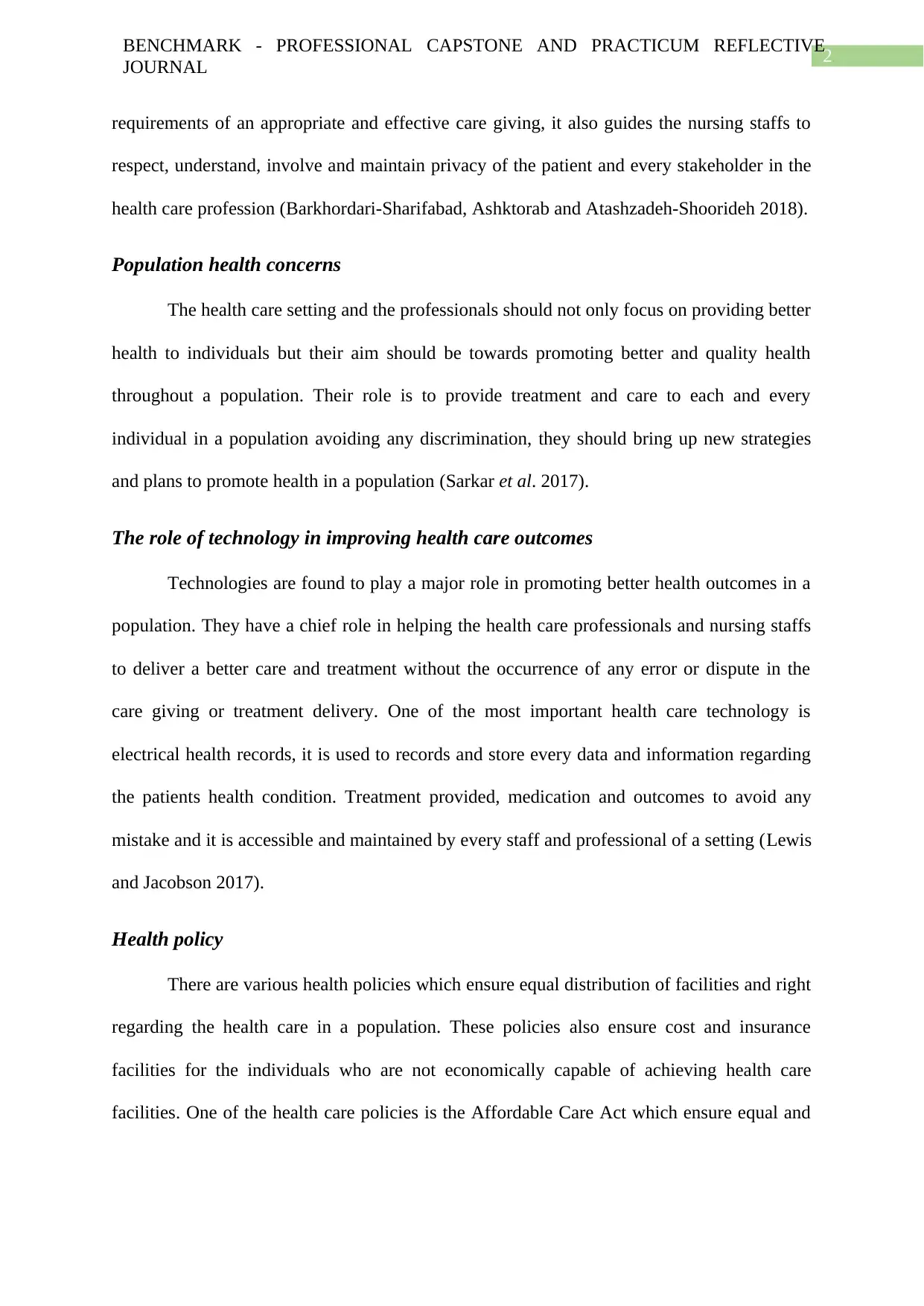
2
BENCHMARK - PROFESSIONAL CAPSTONE AND PRACTICUM REFLECTIVE
JOURNAL
requirements of an appropriate and effective care giving, it also guides the nursing staffs to
respect, understand, involve and maintain privacy of the patient and every stakeholder in the
health care profession (Barkhordari-Sharifabad, Ashktorab and Atashzadeh-Shoorideh 2018).
Population health concerns
The health care setting and the professionals should not only focus on providing better
health to individuals but their aim should be towards promoting better and quality health
throughout a population. Their role is to provide treatment and care to each and every
individual in a population avoiding any discrimination, they should bring up new strategies
and plans to promote health in a population (Sarkar et al. 2017).
The role of technology in improving health care outcomes
Technologies are found to play a major role in promoting better health outcomes in a
population. They have a chief role in helping the health care professionals and nursing staffs
to deliver a better care and treatment without the occurrence of any error or dispute in the
care giving or treatment delivery. One of the most important health care technology is
electrical health records, it is used to records and store every data and information regarding
the patients health condition. Treatment provided, medication and outcomes to avoid any
mistake and it is accessible and maintained by every staff and professional of a setting (Lewis
and Jacobson 2017).
Health policy
There are various health policies which ensure equal distribution of facilities and right
regarding the health care in a population. These policies also ensure cost and insurance
facilities for the individuals who are not economically capable of achieving health care
facilities. One of the health care policies is the Affordable Care Act which ensure equal and
BENCHMARK - PROFESSIONAL CAPSTONE AND PRACTICUM REFLECTIVE
JOURNAL
requirements of an appropriate and effective care giving, it also guides the nursing staffs to
respect, understand, involve and maintain privacy of the patient and every stakeholder in the
health care profession (Barkhordari-Sharifabad, Ashktorab and Atashzadeh-Shoorideh 2018).
Population health concerns
The health care setting and the professionals should not only focus on providing better
health to individuals but their aim should be towards promoting better and quality health
throughout a population. Their role is to provide treatment and care to each and every
individual in a population avoiding any discrimination, they should bring up new strategies
and plans to promote health in a population (Sarkar et al. 2017).
The role of technology in improving health care outcomes
Technologies are found to play a major role in promoting better health outcomes in a
population. They have a chief role in helping the health care professionals and nursing staffs
to deliver a better care and treatment without the occurrence of any error or dispute in the
care giving or treatment delivery. One of the most important health care technology is
electrical health records, it is used to records and store every data and information regarding
the patients health condition. Treatment provided, medication and outcomes to avoid any
mistake and it is accessible and maintained by every staff and professional of a setting (Lewis
and Jacobson 2017).
Health policy
There are various health policies which ensure equal distribution of facilities and right
regarding the health care in a population. These policies also ensure cost and insurance
facilities for the individuals who are not economically capable of achieving health care
facilities. One of the health care policies is the Affordable Care Act which ensure equal and
⊘ This is a preview!⊘
Do you want full access?
Subscribe today to unlock all pages.

Trusted by 1+ million students worldwide
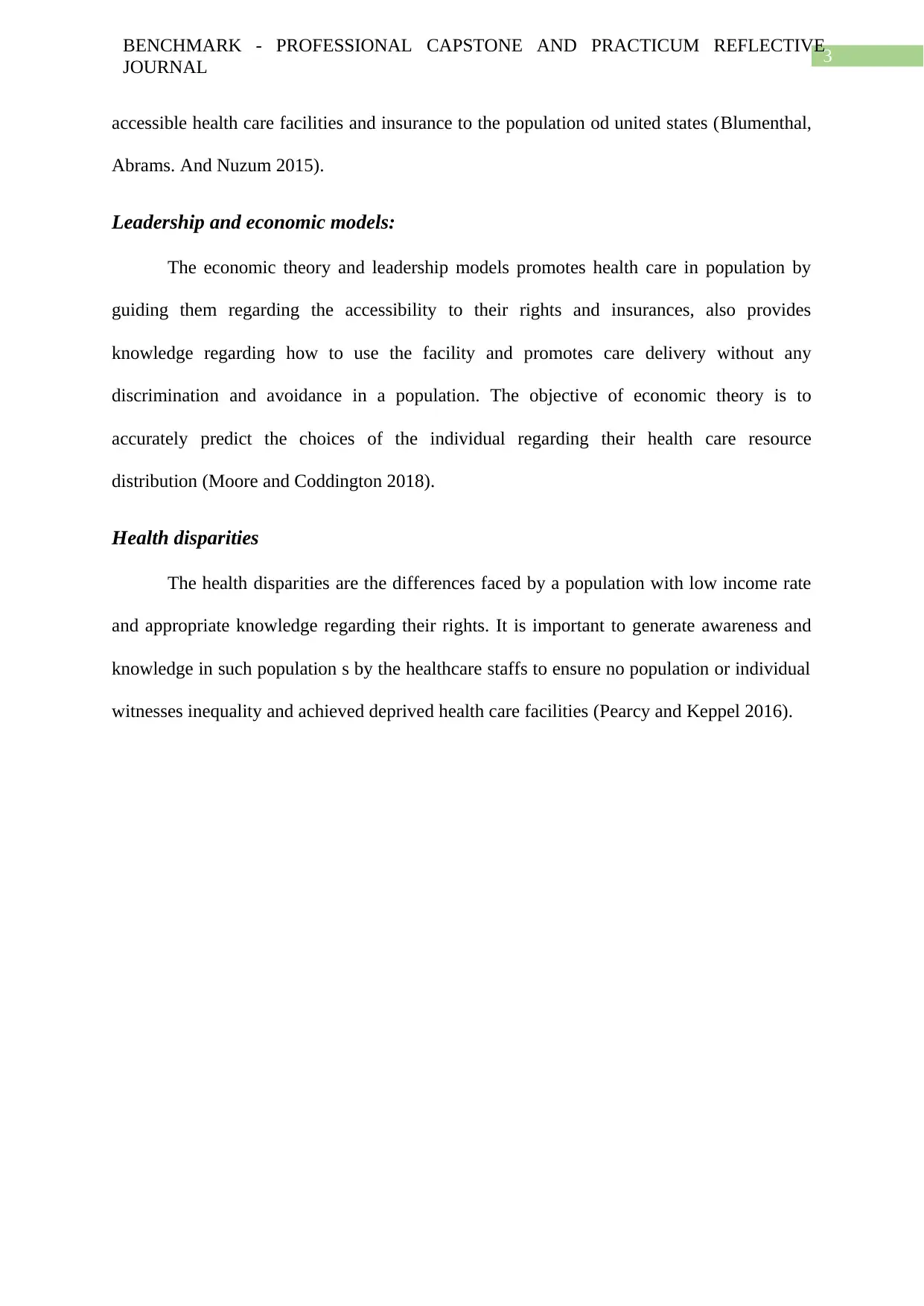
3
BENCHMARK - PROFESSIONAL CAPSTONE AND PRACTICUM REFLECTIVE
JOURNAL
accessible health care facilities and insurance to the population od united states (Blumenthal,
Abrams. And Nuzum 2015).
Leadership and economic models:
The economic theory and leadership models promotes health care in population by
guiding them regarding the accessibility to their rights and insurances, also provides
knowledge regarding how to use the facility and promotes care delivery without any
discrimination and avoidance in a population. The objective of economic theory is to
accurately predict the choices of the individual regarding their health care resource
distribution (Moore and Coddington 2018).
Health disparities
The health disparities are the differences faced by a population with low income rate
and appropriate knowledge regarding their rights. It is important to generate awareness and
knowledge in such population s by the healthcare staffs to ensure no population or individual
witnesses inequality and achieved deprived health care facilities (Pearcy and Keppel 2016).
BENCHMARK - PROFESSIONAL CAPSTONE AND PRACTICUM REFLECTIVE
JOURNAL
accessible health care facilities and insurance to the population od united states (Blumenthal,
Abrams. And Nuzum 2015).
Leadership and economic models:
The economic theory and leadership models promotes health care in population by
guiding them regarding the accessibility to their rights and insurances, also provides
knowledge regarding how to use the facility and promotes care delivery without any
discrimination and avoidance in a population. The objective of economic theory is to
accurately predict the choices of the individual regarding their health care resource
distribution (Moore and Coddington 2018).
Health disparities
The health disparities are the differences faced by a population with low income rate
and appropriate knowledge regarding their rights. It is important to generate awareness and
knowledge in such population s by the healthcare staffs to ensure no population or individual
witnesses inequality and achieved deprived health care facilities (Pearcy and Keppel 2016).
Paraphrase This Document
Need a fresh take? Get an instant paraphrase of this document with our AI Paraphraser
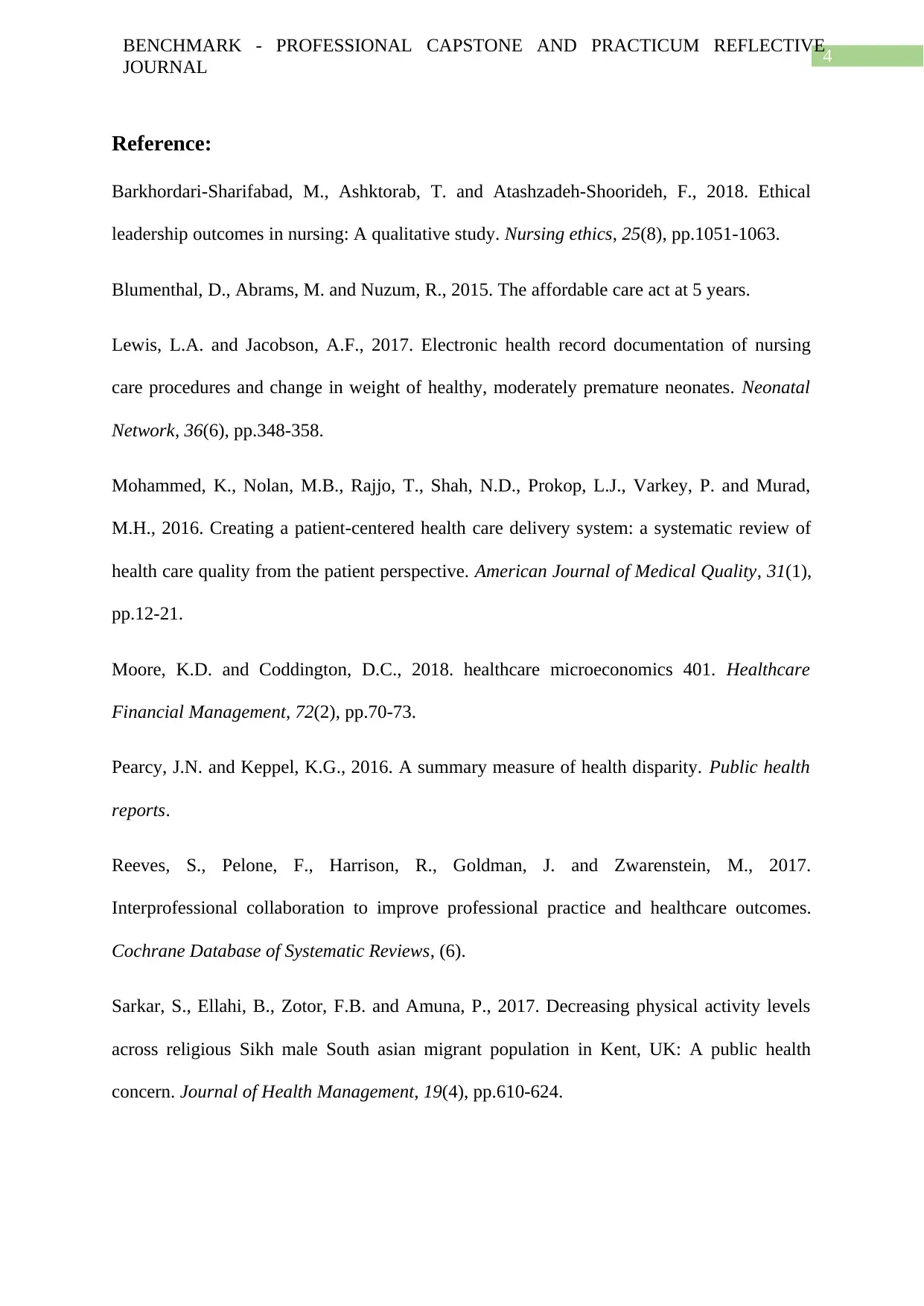
4
BENCHMARK - PROFESSIONAL CAPSTONE AND PRACTICUM REFLECTIVE
JOURNAL
Reference:
Barkhordari-Sharifabad, M., Ashktorab, T. and Atashzadeh-Shoorideh, F., 2018. Ethical
leadership outcomes in nursing: A qualitative study. Nursing ethics, 25(8), pp.1051-1063.
Blumenthal, D., Abrams, M. and Nuzum, R., 2015. The affordable care act at 5 years.
Lewis, L.A. and Jacobson, A.F., 2017. Electronic health record documentation of nursing
care procedures and change in weight of healthy, moderately premature neonates. Neonatal
Network, 36(6), pp.348-358.
Mohammed, K., Nolan, M.B., Rajjo, T., Shah, N.D., Prokop, L.J., Varkey, P. and Murad,
M.H., 2016. Creating a patient-centered health care delivery system: a systematic review of
health care quality from the patient perspective. American Journal of Medical Quality, 31(1),
pp.12-21.
Moore, K.D. and Coddington, D.C., 2018. healthcare microeconomics 401. Healthcare
Financial Management, 72(2), pp.70-73.
Pearcy, J.N. and Keppel, K.G., 2016. A summary measure of health disparity. Public health
reports.
Reeves, S., Pelone, F., Harrison, R., Goldman, J. and Zwarenstein, M., 2017.
Interprofessional collaboration to improve professional practice and healthcare outcomes.
Cochrane Database of Systematic Reviews, (6).
Sarkar, S., Ellahi, B., Zotor, F.B. and Amuna, P., 2017. Decreasing physical activity levels
across religious Sikh male South asian migrant population in Kent, UK: A public health
concern. Journal of Health Management, 19(4), pp.610-624.
BENCHMARK - PROFESSIONAL CAPSTONE AND PRACTICUM REFLECTIVE
JOURNAL
Reference:
Barkhordari-Sharifabad, M., Ashktorab, T. and Atashzadeh-Shoorideh, F., 2018. Ethical
leadership outcomes in nursing: A qualitative study. Nursing ethics, 25(8), pp.1051-1063.
Blumenthal, D., Abrams, M. and Nuzum, R., 2015. The affordable care act at 5 years.
Lewis, L.A. and Jacobson, A.F., 2017. Electronic health record documentation of nursing
care procedures and change in weight of healthy, moderately premature neonates. Neonatal
Network, 36(6), pp.348-358.
Mohammed, K., Nolan, M.B., Rajjo, T., Shah, N.D., Prokop, L.J., Varkey, P. and Murad,
M.H., 2016. Creating a patient-centered health care delivery system: a systematic review of
health care quality from the patient perspective. American Journal of Medical Quality, 31(1),
pp.12-21.
Moore, K.D. and Coddington, D.C., 2018. healthcare microeconomics 401. Healthcare
Financial Management, 72(2), pp.70-73.
Pearcy, J.N. and Keppel, K.G., 2016. A summary measure of health disparity. Public health
reports.
Reeves, S., Pelone, F., Harrison, R., Goldman, J. and Zwarenstein, M., 2017.
Interprofessional collaboration to improve professional practice and healthcare outcomes.
Cochrane Database of Systematic Reviews, (6).
Sarkar, S., Ellahi, B., Zotor, F.B. and Amuna, P., 2017. Decreasing physical activity levels
across religious Sikh male South asian migrant population in Kent, UK: A public health
concern. Journal of Health Management, 19(4), pp.610-624.
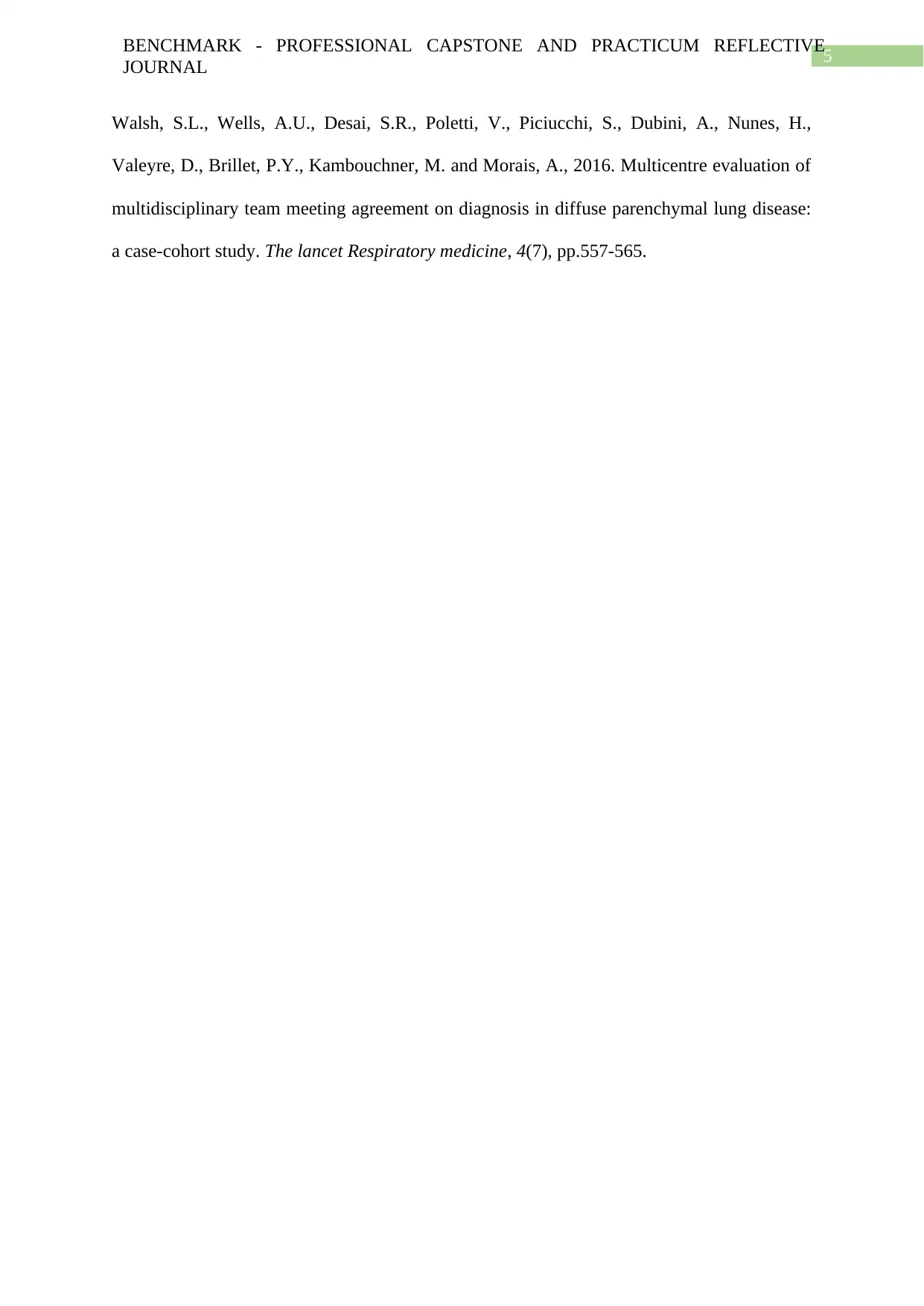
5
BENCHMARK - PROFESSIONAL CAPSTONE AND PRACTICUM REFLECTIVE
JOURNAL
Walsh, S.L., Wells, A.U., Desai, S.R., Poletti, V., Piciucchi, S., Dubini, A., Nunes, H.,
Valeyre, D., Brillet, P.Y., Kambouchner, M. and Morais, A., 2016. Multicentre evaluation of
multidisciplinary team meeting agreement on diagnosis in diffuse parenchymal lung disease:
a case-cohort study. The lancet Respiratory medicine, 4(7), pp.557-565.
BENCHMARK - PROFESSIONAL CAPSTONE AND PRACTICUM REFLECTIVE
JOURNAL
Walsh, S.L., Wells, A.U., Desai, S.R., Poletti, V., Piciucchi, S., Dubini, A., Nunes, H.,
Valeyre, D., Brillet, P.Y., Kambouchner, M. and Morais, A., 2016. Multicentre evaluation of
multidisciplinary team meeting agreement on diagnosis in diffuse parenchymal lung disease:
a case-cohort study. The lancet Respiratory medicine, 4(7), pp.557-565.
⊘ This is a preview!⊘
Do you want full access?
Subscribe today to unlock all pages.

Trusted by 1+ million students worldwide
1 out of 6
Related Documents
Your All-in-One AI-Powered Toolkit for Academic Success.
+13062052269
info@desklib.com
Available 24*7 on WhatsApp / Email
![[object Object]](/_next/static/media/star-bottom.7253800d.svg)
Unlock your academic potential
Copyright © 2020–2025 A2Z Services. All Rights Reserved. Developed and managed by ZUCOL.





